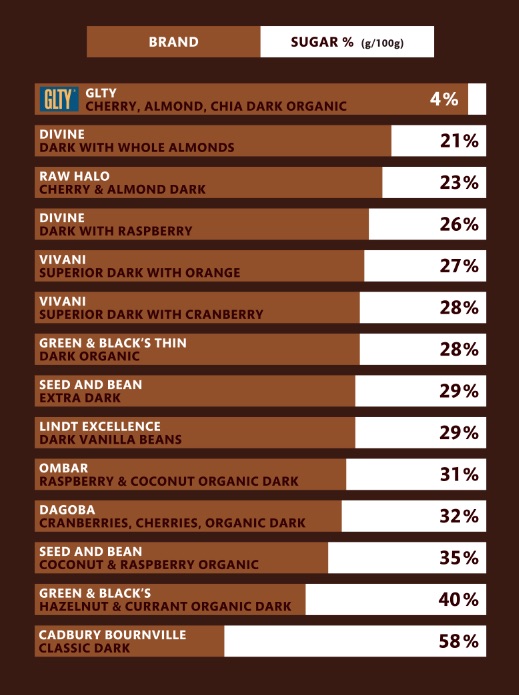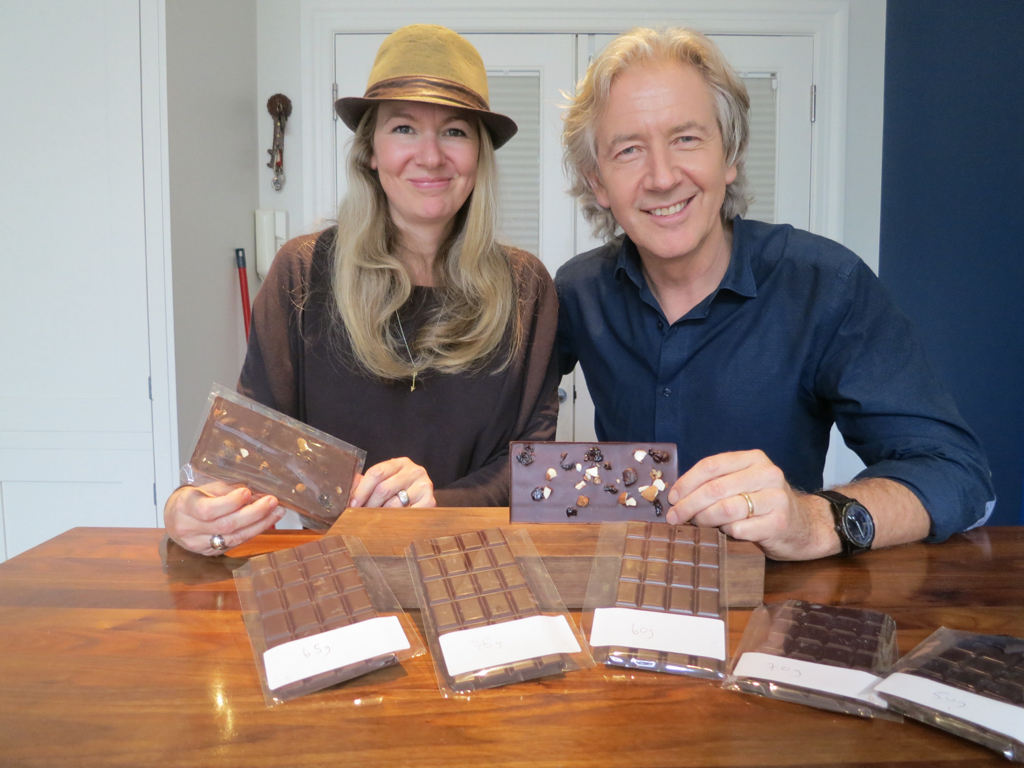If I’m invited to dinner the chances are I’ll buy a bar of ‘healthy’ organic dark chocolate for my hosts. But just how healthy is chocolate, even the dark 70% cacao organic brands? I decided to investigate.
Firstly, dark chocolate does tend to have less sugar than milk chocolate and more cacao which, as you’ll see, has some very interesting health benefits. I decided to home in on higher (eg 60 to75%) cacao dark chocolates, some containing nuts others cherries or dried fruits. (Why these criteria, you might wonder? Because I’ve set myself a target – to make the tastiest, healthiest ever chocolate, working with chocolatier Cheryl Ellis from Just Chocolate. More on this in a minute.)
Most ‘healthy’ chocolates are 30% sugar
I picked the best organic and or high cacao ‘dark dozen’ that I could find in my local health store and supermarket to analyse their sugar content. The average was over 29% sugar! The best in regards to sugar content was Divine’s organic dark chocolate with almonds, with 21% sugar, the worst Green & Black’s organic dark hazelnut & raisin with 40%. Bog standard Cadbury’s Bournville dark chocolate, by comparison, is 58% sugar.
Remember the big announcement by the WHO, backed up (after year’s of resistance) by governments to cut sugar intake to 5% of calories or roughly 5 heaped teaspoons of sugar a day? Well, the average of these organic dark chocolate bars equates to 26 grams of sugar in a standard 100gram bar, or 6.5 teaspoons of sugar.

Why so much? Well, apart from our sweet tooth, the cheapest ingredient in chocolate is sugar and the most expensive is cacao. So the more sugar you put in the more money you stand to make. And, of course, we are all addicted to sugar.
As you reel from this revelation I want to tell you how it is possible to make a delicious tasting and sweet chocolate with cherries and almonds with a fraction of the sugar content, namely 4% sugar –that’s ten times less sugar than what’s out there with dark ‘fruit & nut’ varieties. But also, if you swap out a quarter of the bar’s sugar it also means you have a quarter more cacao. So that’s better value for money and health.
The truth about cacao and the myth of ‘raw’ chocolate
Before exploring the health benefits and downsides of chocolate it’s worth knowing a bit about what it is. The cacao bean, like coffee, tends to be roasted at high temperatures to create chocolate. (Cocoa powder is pretty much the same thing but is typically the result of heavier processing and roasting at higher temperatures.)
‘Raw’ chocolate is a myth because all chocolate must be fermented, which generates a lot of heat, and so-called raw chocolate makers might do this on tin roofs where the temperature cannot be controlled or verified. So, generally, ‘raw’ means unroasted cacao beans. The benefit of this is a higher flavonoid content, because over 43 degrees there is some nutrient degradation. Top chocolatiers buy unroasted beans and keep the temperature below 43 degrees during the making of it. This you can buy as ‘unroasted’ chocolate.
The health benefits of cacao hinge around its high levels of flavonoids, mainly epicatechins and catechins. These are powerful polyphenols with big antioxidantAntioxidants are substances that protect cells within the body from damage caused by free radicals. They help to strengthen the body’s ability to fight infection… effects. Flavonoids are renowned for their health-promoting antioxidant and anti-inflammatory effects as well as protecting the brain and cognition (1,2). Cacao has been shown to improve cardiovascular health by reducing blood clotting, blood pressure and reducing inflammation (3). How much of this is just due to the flavonoids or the total effect of what’s in cacao is not yet clear. Some studies have shown an increase in nitric oxide synthesis (that’s what Viagra does) which lowers blood pressure (4). It also improves oxygen availability and has been shown to have benefits for athletes wishing to increase endurance (5). Olympic gold medallist Jessica Ennis-Hill snacks on it before training.
The cardiovascular effect is clearest in long-term studies on people who eat cacao/chocolate on a regular basis compared to those who don’t. There is also growing evidence that chocolate consumption is associated with better cognitive abilities and consequently may reduce dementia risk which has also been found with other flavonoid rich foods (6).
Chocolate contains a little caffeine but its main stimulant is theobromine. This also has a mild vasodilative and diureticA diuretic is a substance that increases the amount of urine produced and therefore makes you urinate more frequently…. effect (7) which is another mechanism by which chocolate could lower blood pressure. Theobromine has also been shown to raise the good ‘HDL’ cholesterol fraction (8).
Why dark chocolate is better than milk chocolate
While dark chocolate increases the antioxidant capacity, the interaction between between milk proteins and chocolate flavonoids seems to inhibit this beneficial effect and the ability to absorb the epicatechin, the active flavonoid, into the bloodstream (9). Milk chocolate also tends to have more sugar. Also, in a ‘crossover’ study comparing dark with milk chocolate, those eating dark chocolate felt more satisfied and less desire to eat something sweet, thus eating less (10).
Making the ‘perfect’ chocolate
Knowing all this I set off to design the ‘perfect’ nutrient rich chocolate with a low GL, working with chocolatier Cheryl Ellis from Just Chocolate.

Firstly we selected the best organic unroasted 75% criollo cacao from Peru. Then I sourced montmorency cherries, which are exceptionally high in antioxidants, and predominantly containing xylose, a very low GL sugar, both for their health benefits and because they taste sweet but have very little effect on blood sugar. Nine teaspoons of crystalline xylose (xylitolXylitol is a completely natural sweetener that looks and tastes like sugar. It is naturally occurring in many fruits and vegetables….) has the same blood sugar effect as one teaspoon of sugar. (I also like erythritol, another ‘sugar alcohol’ that has zero calories).
Apart from the cherries the main sweetener is chicory root fibreFibre is an important part of a balanced diet. There are two type of fibre; soluble and insoluble. Insoluble fibre helps your bowel to pass… which tastes sweet but is a resistant starch. I wrote about these in my last newsletter because resistant starches act as prebiotics, nourishing healthy gut bacteria, but are not absorbed so have no ‘sugar’ content despite tasting sweet.
Then, I wanted to up the proteinProteins are large molecules consisting of chains of amino acids. Proteins are essential nutrients for the human body – they are a building block of… content so we added soaked organic almonds, dried at low temperatures, also adding a rich source of magnesiumWhat it does: Strengthens bones and teeth, promotes healthy muscles by helping them to relax, also important for PMS, important for heart muscles and nervous…, and then for a further crunch and extra nutrition we added chia seeds, the highest vegetarian source of omega-3 fats, both being health and heart-friendly nutrients. Chocolate is high in protein and further increasing the protein lowers the glycemic load (GL). Also, with a lot less sugar that means you get a lot more cacao.
The result was an absolutely delicious cherry, almond, chia dark chocolate with the equivalent of 1 GL per 12.5g (quarter of a 50g bar) serving. Those following a GL friendly diet will know that a ‘snack’ should be no more than 5 GLs. It is absolutely delicious, not unsweet but obviously not as sweet tasting as most high sugar chocolates, but containing only 2 grams of sugar, that’s half a teaspoon in a 50 gram bar. I believe we have shown that you can make a truly healthy and delicious snack with real food. I hope this points the way forward for healthier chocolates in the future.
REFERENCES
1. Williams RJ, Spencer JPE, and Rice-Evans C. Flavonoids: Antioxidants Or Signalling Molecules? Free Radical Biology and Medicine, vol 36, 2004, pp. 838-849. http://www.sciencedirect.com/science/article/pii/S0891584904000334
2. Williams RJ, Spencer JPE, and Rice-Evans C. Flavonoids: Antioxidants Or Signalling Molecules? Free Radical Biology and Medicine, vol 36, 2004, pp. 838-849. http://www.sciencedirect.com/science/article/pii/S0891584904000334
3. Aidoo RP. et al. Industrial Manufacture Of Sugar-Free Chocolates – Applicability Of Alternative Sweeteners And CarbohydrateCarbohydrates are the primary source of energy for the body as they can be broken down into glucose (sugar) more readily than either protein or… Polymers As Raw Materials In Product Development. Trends in Food Science & Technology, Vol 32 (2), 2013, pp. 84-96. http://www.sciencedirect.com/science/article/pii/S092422441300112X; see also Steinberg FM, Bearden MM and Keen CL. Cocoa And Chocolate Flavonoids: Implications For Cardiovascular Health. Journal of the American Dietetic Association, vol 103(2), 2003, pp. 215-223.
4. Fisher NDL and Hollenberg NK. Flavanols For Cardiovascular Health: The Science Behind The Sweetness. Journal of HypertensionHypertension is more commonly known as high blood pressure…., Vol 23 (8), 2005, pp. 1453-1459. http://journals.lww.com/jhypertension/Abstract/2005/08000/Flavanols_for_cardiovascular_health__the_science.3.aspx; see also Engler MB. et al. Flavonoid-Rich Dark Chocolate Improves Endothelial Function And Increases Plasma Epicatechin Concentrations In Healthy Adults. Journal of the American College of Nutrition, Vol 23(3), 2004, pp. 197-204. http://www.tandfonline.com/doi/abs/10.1080/07315724.2004.10719361
5. Patel RK, Brouner J and Spendiff O. Dark Chocolate Supplementation Reduces The Oxygen Cost Of Moderate Intensity Cycling. Journal of International Society of Sports Nutrition, vol 12(47), 2015, pp. 1-8. http://www.ncbi.nlm.nih.gov/pubmed/26674253
6. Nurk E. et al. Intake Of Flavonoid-Rich Wine, Tea, And Chocolate By Elderly Men And Women Is Associated With Better Cognitive Test Performance. Journal of Nutrition, vol 139(1), 2008, pp.120-127. http://jn.nutrition.org/content/139/1/120.long
7. McShea A. et al. Clinical Benefit And Preservation Of Flavonols In Dark Chocolate Manufacturing. Nutrition Reviews, vol 66(11), 2008, pp.630-641. http://nutritionreviews.oxfordjournals.org/content/66/11/630.abstract
8. Neufingerl N. et al. Effect Of Cocoa And Theobromine Consumption On Serum HDL-Cholesterol Concentrations: A Randomized Controlled Trial, American Journal of Clinical Nutrition, vol 97(6), 2013, pp. 1201-1209. http://ajcn.nutrition.org/content/97/6/1201.full
9. Serafini M. et al. Plasma Antioxidants From Chocolate. Nature, vol 424(6952), 2003, pp.1013-1013. http://www.nature.com/nature/journal/v424/n6952/abs/4241013a.html. ; see also Schroeter H. et al. Nutrition: Milk And Absorption Of Dietary Flavanols. Nature, vol 426 (6968), 2003, pp. 787-788. http://www.nature.com/nature/journal/v426/n6968/pdf/426787b.pdf ; see also Keogh JB, McInerney J and Clifton PM. The Effect Of Milk Protein On The Bioavailability Of Cocoa Polyphenols. Journal of Food Science, Vol 72(3), 2007, pp. S230-S233. http://www.ncbi.nlm.nih.gov/pubmed/17995820
10. Sørensen LB and Astrup A. Eating Dark And Milk Chocolate: A Randomized Crossover Study Of Effects On Appetite And Energy Intake. Nutrition & Diabetes, vol 1(12), 2011, pp. e21. http://www.nature.com/nutd/journal/v1/n12/abs/nutd201117a.html

Comments
Join the Conversation on our Facebook Page